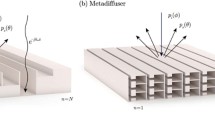Abstract
It is well established that Schroeder diffusers may be used as surface treatment to promote diffuse sound fields in auditoria over a target frequency range. Quadratic Residue Diffusers are very effective within a design frequency bandwidth, and this frequency bandwidth may be significantly extended by a nested or fractal design. Publicly available data typically publish diffusion coefficients separately for the parent diffuser and the child diffuser, with some ambiguity surrounding the effect the two levels have on each other, and the performance at ‘crossover’ frequencies. This paper uses an optimised 2D boundary element method to investigate the differences in results when the parent and child diffusers are modelled separately, and as an integrated design. It is found that the scattering properties of the child diffuser are significantly modified by the well of the parent diffuser in which it is placed. More interestingly, the excellent scattering properties of the fractal design may be achieved with only a minor loss of bandwidth using a far simpler and more robust geometry in which the child diffuser is replaced by a concave surface at the base of the well in the parent diffuser. The paper outlines the optimisation of the boundary element code for this task, and compares results for a variety of well bottom shapes with the fractal design.









Similar content being viewed by others
References
Everest, F.A., Pohlmann, K.C.: Master Handbook of Acoustics, 5th edn. McGraw-Hill, New York (2009)
Cox, T., D’Antonio, P.: Acoustic Absorbers and Diffuser: Theory Design and Application. CRC Press, London (2009)
Schroeder, M.R.: Diffuse sound reflection by maximum-length sequences. J. Acoust. Soc. Am. 57(1), 149–150 (1975)
D’Antonio, P., Konnert, J.: The QRD diffractal: a new one- or two-dimensional fractal sound diffusor. J. Audio Eng. Soc. 40(3), 117–129 (1992)
Rocchi, L.: Quadratic residue diffusers: modelling through the boundary element method. BE(Hons) Thesis, University of Tasmania (2014)
Kirkup, S.: The Boundary Element Method in Acoustics. Integrated Sound Software, Heptonstall (1998)
Lock, A.: Development of a 2D boundary element method to model Schroeder acoustic diffusers, BE(Hons) Thesis University or Tasmania (2014)
Abramowitz, M., Stegun, I.A.: Handbook of Mathematical Functions with Formulas, Graphs and Mathematical Tables. Applied Mathematics Series, vol. 55. National Bureau of Standards, Washington, DC (1964)
Wu, T.W.: A direct boundary element method for acoustic radiation and scattering from mixed regular and thin bodies. J. Acoust. Soc. Am. 97(1), 84–91 (1995)
Morse, P.M., Ingard, K.U.: Theoretical Acoustics. Princeton University Press, Princeton (1986)
Kuyama, T.: Some calculated results of the diffraction of sound waves by a cylindrical obstacle. Proc. Physico-Mathematical Soc. Jpn. 15, 366–370 (1933)
Wiener, F.M.: Sound diffraction by rigid spheres and circular cylinders. J. Acoust. Soc. Am. 19(3), 444–451 (1947)
Schroeder, M.R.: Binaural dissimilarity and optimum ceilings for concert halls: more lateral sound diffusion. J. Acoust. Soc. Am. 65(4), 958–963 (1979)
ISO 17497-2:2012: Acoustics—Sound-Scattering Properties of Surfaces Part 2: Measurement of the Directional Diffusion Coefficient in a Free Field. International Organization for Standardization, Geneva (2012)
Fujiwara, K., Miyajima, T.: Absorption characteristics of a practically constructed Schroeder diffuser of quadratic-residue type. Appl. Acoust. 35(2), 149–152 (1992)
Fujiwara, K.: A study on the sound absorption of a quadratic-residue type diffuser. Acta Acust. United Acust. 81(4), 370–378 (1995)
Acknowledgments
The authors are grateful to Luca Rocchi, who wrote the original BEM code that has been developed for this work.
Author information
Authors and Affiliations
Corresponding author
Additional information
This paper is based on the conference submission that received the Best Student Paper Award, sponsored by Resonate Acoustics, at the Australian Acoustical Society Conference, November 15-18, 2015.
Rights and permissions
About this article
Cite this article
Lock, A., Holloway, D. Boundary Element Modelling of a Novel Simple Enhanced Bandwidth Schroeder Diffuser Offering Comparable Performance to a Fractal Design. Acoust Aust 44, 137–147 (2016). https://doi.org/10.1007/s40857-016-0049-4
Received:
Accepted:
Published:
Issue Date:
DOI: https://doi.org/10.1007/s40857-016-0049-4




